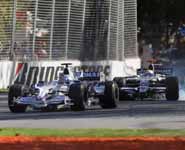The Science, Engineering and Technology (SET) Awards are Britain and Ireland’s most important awards for science and engineering undergraduates, and are sponsored, supported and judged by industry leaders and professional institutions.
Niall designed an electrical drive system and Digital Signal Processor based closed-loop controller for a previously developed prototype electromagnetic gear change actuator. The resulting gear change system was then incorporated into an F1 gearbox and used to demonstrate reliable selection of gear ratios in timeframes comparable with those achieved with current F1 gearboxes.
Motivation for the project, led by Dr Derrick Holliday, Senior Lecturer in the Electrical Energy Management Group at the University, was the demonstration of the significant advantages in terms of reliability, weight reduction, ruggedness and controllability that can be achieved by the replacement of traditional pneumatic, mechanical or hydraulic gear change systems with a “more-electric” gear change system.
New F1 regulations allow on-board storage of electrical energy that can be used to drive electrical systems of the type demonstrated in this project. The technology could also be applied to a range of vehicle transmission components, such as active differentials and clutches, found on high performance rally cars and the automatic driver assist systems commonly found in modern family saloon cars.
Niall said: “I was thrilled to receive the award and it is great recognition of the work I contributed to the project.”
Dr Holliday added: “Niall has clearly demonstrated excellence in his undergraduate research project and we are delighted for him. We hope that Niall’s demonstrator will help us to attract new funding to further develop the technology and to investigate new areas in which it may be applied.”
